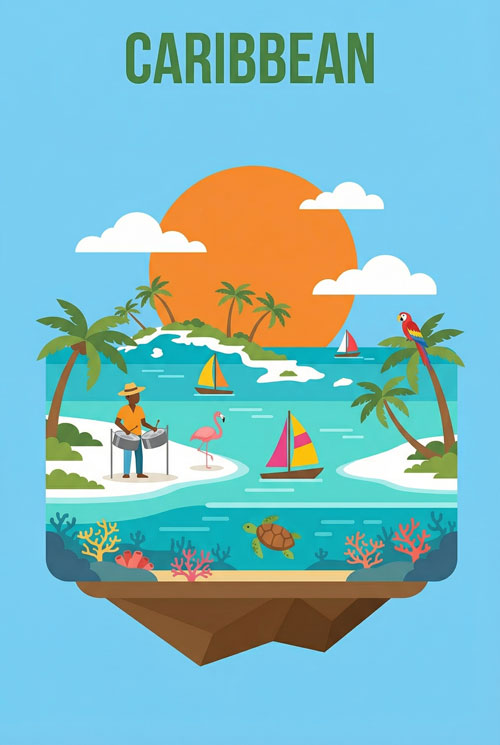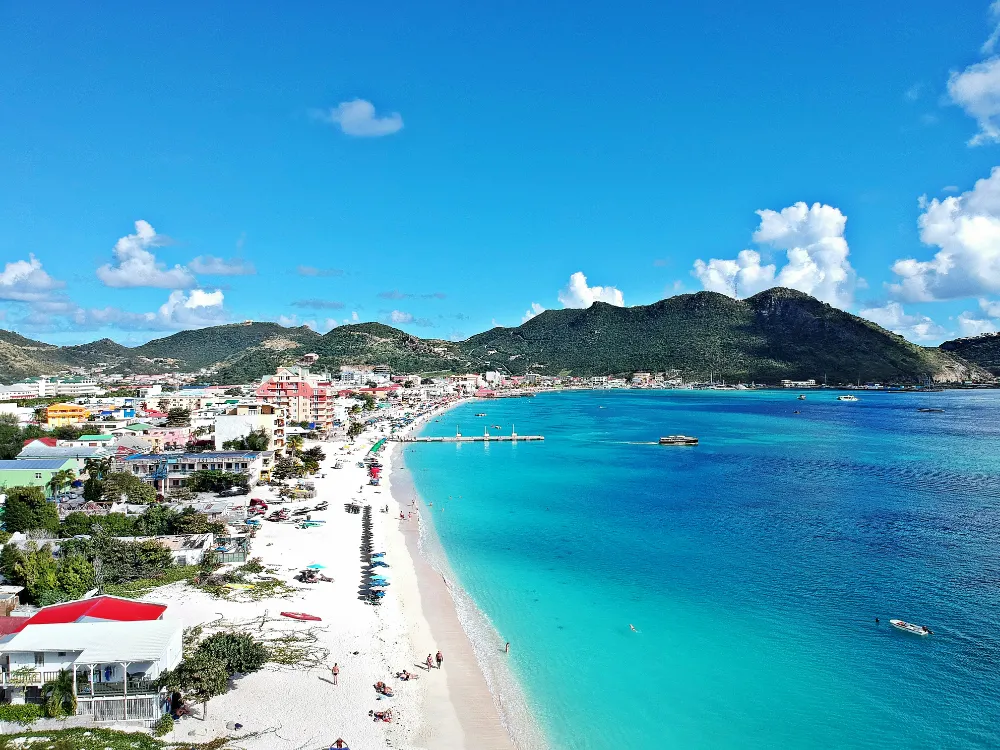eSIM Saint Martin
The Best Time to Visit Saint Martin (French Side)
This guide is designed to help you find your personal sweet spot. We’ll break down the year season by season, analyzing three key factors: your ideal Weather, your Budget, and your preferred Vibe, so you can plan the perfect French Caribbean escape.
Saint Martin At-a-Glance: Your Perfect Season in Seconds
For those who want the highlights right now, here’s a quick guide to help you pinpoint the perfect time for your trip based on your top priorities.
| Traveler Priority | Best Months | Why It’s the Best Time |
| Flawless Beach Weather | December – April | This is the official dry season. Expect maximum sunshine, the lowest humidity, cooling trade winds, and the calmest seas. Temperatures average a perfect 80∘F (27∘C). |
| Ultimate Budget Travel | August – October | This is the heart of the low season. You’ll find the absolute lowest prices on flights and hotels, with hotel rates dropping by as much as 65% compared to peak season. |
| Fewer Crowds, Great Value | May – June & November | These are the “shoulder seasons.” You get beautiful weather, but with significantly fewer tourists and lower prices than the high season. Most businesses are open, offering a relaxed vibe. |
| Festivals & Culture | February – March | The French side’s vibrant pre-Lenten Carnival takes over Marigot. This period also includes the famous “Les Mardis de Grand Case” street festival. |
| Gourmet Foodie Tour | November | The prestigious Festival de la Gastronomie (Festival of Gastronomy) is held, celebrating the island’s culinary prowess. It’s also when all restaurants reopen and buzz with energy for the new season. |
| Snorkeling & Diving | February – May | The dry season offers the calmest seas and the best underwater visibility, making it ideal for exploring sites like Creole Rock and Tintamarre Island. |
| Hiking & Nature | December – April | The dry season ensures trails, like the one up Pic Paradis at Loterie Farm, are safer, less slippery, and more comfortable to explore. |
A Deep Dive: Saint Martin Through the Seasons
To truly understand the rhythm of the island, it helps to look at the year in three distinct phases: the sun-drenched High Season, the value-packed Shoulder Season, and the tranquil Low Season. Each offers a completely different experience.
High Season (December – April): The Sun-Seeker’s Paradise
This is the classic Caribbean postcard experience. The high season in Saint-Martin is defined by idyllic weather, a bustling atmosphere, and a calendar packed with exciting events. It’s the most popular time to visit, and for good reason.
Weather Deep Dive
This period perfectly aligns with the island’s dry season. The weather is exceptionally stable and pleasant, with average daily temperatures hovering between 79∘F and 83∘F (26∘C to 28∘C). Evenings are comfortable, with lows rarely falling below 72∘F (22∘C).
This is the time of year with the most sunshine and the clearest skies; January, for instance, is clear or partly cloudy an incredible 81% of the time. Rainfall is minimal and typically comes in the form of brief, passing showers that quickly give way to more sun. March boasts the lowest average rainfall of the entire year, making it a prime month for uninterrupted beach time.
Crucially, the humidity is at its lowest point, and the constant northeast trade winds provide a refreshing breeze that makes the tropical heat feel wonderfully comfortable.
Pros
The primary advantage is the near-perfect weather, which is ideal for all outdoor activities, from sunbathing and swimming to hiking and sailing. The island is buzzing with energy, and all restaurants, shops, and tour operators are open and in full swing. The social calendar is packed, offering visitors a chance to experience the island at its most festive.
Cons
The downside of perfection is popularity. This is the most expensive time to visit Saint-Martin. Prices for flights and accommodations are at their absolute peak, especially during the holiday weeks of Christmas, New Year’s, and later in the season around Easter and North American Spring Break. Crowd levels are also at their highest, meaning beaches are busier and reservations for popular restaurants are essential. To secure your preferred hotel, it’s highly recommended to book at least six months in advance.
Don’t Miss Events
- French Side Carnival (February/March): This is the cultural centerpiece of the high season. Unlike the Dutch side’s post-Easter celebration, the French Carnaval is a traditional pre-Lenten festival that fills the streets of Marigot with vibrant parades, elaborate costumes, and the infectious rhythms of calypso and soca music. The multi-day event culminates in a grand parade on Mardi Gras (Shrove Tuesday) and the symbolic burning of King Vival on Ash Wednesday.
- Les Mardis de Grand Case (Tuesdays, January-April): Every Tuesday evening, the main boulevard of Grand Case, the island’s culinary capital, transforms into a lively pedestrian-only market. From 6 pm to 10 pm, you can stroll among stalls selling local arts and crafts, listen to live bands, and sample delicious street food, creating a magical, festive atmosphere.
- Heineken Regatta (March): While technically headquartered on the Dutch side, this is one of the largest and most prestigious sailing regattas in the entire Caribbean. The event draws hundreds of yachts and thousands of sailors and spectators from around the globe, creating an electric, island-wide buzz that spills over into the marinas and restaurants of the French side.
The island’s unique dual-nation status creates a remarkable opportunity for festival-goers. The French side holds its Carnival in February or March, while the Dutch side hosts its own massive celebration in April and May.
This scheduling difference means that a visitor arriving in late February could immerse themselves in the Franco-Caribbean traditions of Marigot’s parades, while someone visiting in late April could experience the high-energy jump-ups of the Dutch Carnival.
For those on an extended stay, it’s even possible to experience both. This “two-for-one” cultural offering makes Saint-Martin a premier Carnival destination, providing double the opportunity for celebration.
Shoulder Season (May – June & November): The Savvy Traveler’s Secret
For many seasoned travelers, the shoulder months are the true sweet spot for a Saint-Martin vacation. This period offers a fantastic compromise, blending great weather with fewer crowds and significantly lower prices, allowing for a more relaxed and spontaneous trip.
Weather Deep Dive
These months act as a transition between the dry and wet seasons. Temperatures begin to climb slightly, and humidity increases, but the weather remains very pleasant overall. In May, you can expect average daily highs around 84∘F (29∘C) and about 10 hours of sunshine per day, though rainfall does increase to around 4 inches (102mm) for the month.
November sits at the very end of the hurricane season and is historically one of the wettest months. However, this shouldn’t be a deterrent. The rain typically falls in short, intense, and often refreshing downpours rather than all-day drizzles. This is also the month when the cooling trade winds make their welcome return, clearing the air after the stormier months.
Pros
The biggest advantage of the shoulder season is the value. You get to enjoy beautiful Caribbean weather at a fraction of the high-season cost. With fewer tourists, beaches are more spacious, and you can often snag a table at top restaurants without a reservation made weeks in advance. Hotel availability is much better, opening the door for great deals and last-minute bookings. Almost all businesses are open, especially in November as they gear up for the coming peak season.
Cons
The trade-off for better value is a slightly higher chance of rain compared to the winter months. May and June mark the official start of the Atlantic hurricane season, while November is at the tail end of it. While the risk of a major storm is still low during these specific months, it’s a factor to be aware of.
Don’t Miss Events
- Fish Day (June): Held in the fishing village of Cul-de-Sac, this lively festival is a tribute to the island’s rich fishing heritage. It’s a fantastic opportunity to sample incredibly fresh seafood, from grilled lobster to conch, prepared by local chefs and fishermen, all while enjoying live Caribbean music.
- Fête de la Mer (June): Taking place in Grand Case, the “Festival of the Sea” celebrates Saint-Martin’s deep connection to the ocean with a variety of water activities, including kayaking, sailing, and snorkeling, often with free boat rides and workshops on marine conservation.
- Festival de la Gastronomie (November): This is a must for any food lover. For one week in mid-November, the French side hosts a world-class culinary festival. Renowned international chefs join local masters for cooking demonstrations, competitions, and special gourmet menus at restaurants across the island, cementing Saint-Martin’s status as a foodie paradise.
- St. Martin’s Day (November 11): A significant public holiday celebrating the peaceful unity of the island. The official ceremonies, filled with music, dance, and cultural performances, alternate between the French capital (Marigot) and the Dutch capital (Philipsburg) each year, making it a powerful display of the island’s shared heritage.
November presents a particularly interesting opportunity that goes beyond just being a “shoulder” month. While it is statistically the rainiest month, it also hosts the island’s most prestigious culinary event, the Festival de la Gastronomie.
The end of the official hurricane season on November 30th acts as a signal for the tourism industry to awaken from its quieter period. Restaurants and hotels that may have closed for maintenance in September and October reopen their doors, buzzing with fresh energy for the upcoming high season. The gastronomy festival is strategically placed to kick off this revival.
This creates a unique convergence for a specific type of traveler: the serious foodie. They can capitalize on flight and accommodation prices that are still well below their December peak while experiencing the island’s culinary scene at its most vibrant and celebratory moment. It’s a chance to enjoy a world-class food-focused vacation without the peak-season price tag.
Low Season (July – October): The Ultimate Escape & The Calculated Risk
The low season offers a version of Saint-Martin that many visitors never see: intensely green, incredibly quiet, and exceptionally affordable. It’s a period that requires flexibility and a spirit of adventure, but the rewards can be immense for the right kind of traveler.
Weather Deep Dive
This period is the heart of both the rainy season and the official Atlantic hurricane season, which runs from June 1 to November 30. Temperatures and humidity are at their highest, with daytime highs often reaching into the high 80s or low 90s (30∘C to 32∘C). The peak months for hurricane risk are historically August and September.
While a direct hit on the island is a rare event, the possibility of a tropical storm passing nearby is real. Such a storm can bring several days of high winds and heavy rainfall, potentially disrupting travel plans.
It’s important to understand what “rainy season” actually means here. It doesn’t typically involve constant, dreary rain for days on end. More commonly, the weather pattern consists of hot, sunny mornings followed by heavy, intense afternoon downpours that pass relatively quickly. A major benefit of this rainfall is that the island’s flora becomes incredibly lush and vibrant, transforming the landscape into a rich tapestry of green.
Pros
The most compelling reason to visit during the low season is the cost. You will find the absolute lowest prices on flights and accommodations, with hotel rates sometimes dropping by over 60% compared to the high season. The island is exceptionally quiet. You can have world-famous beaches like Orient Bay almost entirely to yourself, offering a level of tranquility and solitude that’s impossible to find in winter. This period provides a more authentic, local experience, as you’ll be sharing the island primarily with its residents.
Cons
The primary drawback is the weather risk. The threat of a hurricane or tropical storm is a serious consideration, and purchasing comprehensive travel insurance is not just recommended, it’s essential. The combination of high heat and high humidity can be oppressive for those not accustomed to it. Furthermore, many businesses, including some popular restaurants, hotels, and tour operators, close down during the quietest months (especially September and October) for annual maintenance and staff vacations.
Don’t Miss Events
- Bastille Day (July 14): As an overseas collectivity of France, Saint-Martin celebrates the French National Day with patriotic passion. Expect military parades, official ceremonies, and spectacular fireworks displays, particularly around the Marigot waterfront.
- Fête de Grand-Case / Victor Schoelcher Day (July 21): This important cultural festival in Grand Case commemorates Victor Schoelcher, the French abolitionist who led the campaign to end slavery. The day is marked with religious ceremonies, traditional games, and exciting boat races between St. Martin and neighboring Anguilla.
The low season provides a fundamentally different kind of vacation, not just a cheaper one. The weather risk significantly lowers tourist demand, which in turn leads to rock-bottom pricing. This lack of tourist traffic makes it economically practical for many business owners to close for a month or two.
The result is an island that is less commercialized and far more serene. This environment is perfect for the independent, self-sufficient, and budget-driven traveler who values solitude and local immersion above a guaranteed week of sunshine and a bustling nightlife.
It’s a chance to see the “real” Saint-Martin, enjoy its lush landscapes at their greenest, and experience cultural celebrations like Bastille Day alongside locals, free from the usual tourist crowds.
Your Perfect Trip: The Best of Saint Martin by Travel Style
Now that we’ve explored the seasons, let’s put it all together. Here’s our tailored advice for finding your perfect travel window based on your personal style.
For the Budget-Conscious Traveler
- Best Time: September & October
- Strategy: This is the absolute cheapest time to visit Saint-Martin, with the lowest prices on both flights and hotels. To maximize savings, embrace the local food scene. Skip the expensive beachfront restaurants and head to the “lolos” in Grand Case—small, open-air eateries serving incredible and affordable grilled ribs, chicken, and fresh fish.
- Renting a small car for your stay is almost always more economical than relying on taxis, which cater to tourists and have prices to match. Be aware that some businesses will be closed, so a little advance research on what’s open is wise. And most importantly: purchase comprehensive travel insurance to protect your trip from any potential weather disruptions.
For Families with Children
- Best Time: Late June, early July, or during Easter break (March/April).
- Strategy: The dry, sunny weather during the Easter holiday period is perfect for maximizing beach time, though it comes with peak prices and crowds. A fantastic alternative is late June or early July. This window offers a great balance of more affordable shoulder-season pricing and pleasant weather, just before the peak hurricane risk period begins. For families with very young children, a visit to Le Galion Beach is a must. Nicknamed “Baby Beach,” its waters are protected by an outer reef, creating a calm, shallow, and safe lagoon perfect for toddlers and little swimmers.
For Adventurers & Nature Lovers
- Best Time: January – March
- Strategy: This dry-season window is the ultimate time for exploring Saint-Martin’s natural wonders. The hiking trails are in their best condition—dry, safe, and less slippery. A top adventure is the hike to the island’s highest point, Pic Paradis, from the lush nature reserve at Loterie Farm, which rewards you with breathtaking panoramic views. This period also coincides with the peak of the humpback whale migration season, offering chances for incredible whale watching tours. For those who love the world below the waves, the calm seas of the dry season provide the best underwater visibility for snorkeling and diving at prime spots like Tintamarre Island (famous for its sea turtles) and Creole Rock.
For Foodies & Culture Aficionados
- Best Time: November for foodies; February/March for culture.
- Strategy: If your travels are guided by your taste buds, plan your trip for mid-November to coincide with the Festival de la Gastronomie. It’s an unparalleled opportunity to experience the island’s celebrated culinary scene at its peak. For a deep dive into local culture, there’s no better time than during the French Carnival in February or March. The vibrant parades and street parties in Marigot offer a truly immersive cultural experience. For a more regular dose of culture, visit any Tuesday between January and April to experience “Les Mardis de Grand Case,” a wonderful weekly festival of local food, music, and crafts.
Stay Connected in Saint Martin with an eSIM
Touching down at Princess Juliana International Airport (SXM), the last thing you want to worry about is how you’ll get online. Whether you need to pull up directions to your villa in Terres Basses, check the opening hours of a boutique in Marigot, or use a ride-sharing app, having instant data access is essential for a smooth start to your vacation.
Traditionally, travelers have faced two frustrating options. The first is relying on your home carrier’s international roaming plan, which can lead to shocking bill surprises. These plans can cost anywhere from $14 to $18 per day, adding hundreds of dollars to your trip budget.
The second option is hunting down a local physical SIM card upon arrival. This involves finding a store for a provider like Digicel or Flow, waiting in line, and going through a registration process that often requires your passport—all precious time that could be spent on the beach.
Thankfully, there’s a modern, hassle-free solution. With an eSIM from eSIM4.com, you can download a data plan for Saint Martin before you even pack your bags and activate it the moment you land. Say goodbye to bill shock and forget about wasting precious vacation time in airport phone stores. It’s the most convenient and affordable way to stay connected from the second your Caribbean adventure begins.
Ready for seamless connectivity on your trip? Check out eSIM4.com for affordable, reliable data plans for your trip to Saint Martin.













